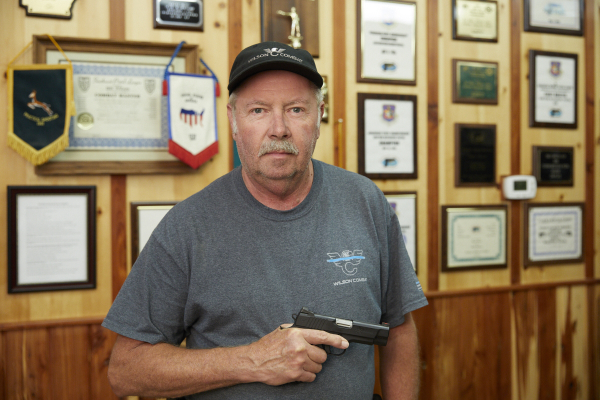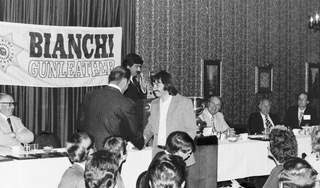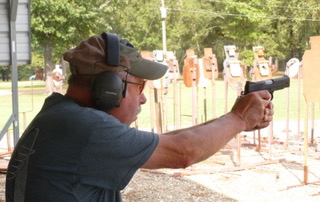This is the latest from our correspondent, Greg Moats –
Through no merit on my part, I was inordinately lucky to be in the right place at the right time. Bill Wilson and I got to be on, if not the ground floor, at least the mezzanine level of the creation of IPSC.
Our History

Six months after the IPSC-founding Columbia Conference, my friend Bill Wilson shot his first match at the Midwest Practical Pistol League (MPPL), the home club that hosted the conference. Nine months after the inaugural Columbia Conference, I was discharged from the Marine Corps, returned to Kansas and also started shooting with MPPL. I’m pretty sure that Bill would agree that it was an amazing club. Dick Thomas who initiated the conference and served as IPSC’s first VP, and top shooter Raul Walters were local participants. Holster maven and fast draw expert Bob Arganbright was a monthly regular. Eventually Ray Chapman and Eddie Brown called MPPL their home club.

My favorite picture that I’ve ever taken of Bill. Here he’s receiving an award at the 1979 Bianchi Cup from Ray Chapman—Bill and I go way back. Moats photo.
|
Oh yes, and there was a recent Air Force veteran with a perpetual grin named Larry Potterfield that shot with us! When you add the name of Bill Wilson to that list it’s a gallery of distinguished celebrities. Though never reaching the eminence of California’s infamous Southwest Pistol League, the level of competition at MPPL was substantial. With Eddie Brown, Larry Potterfield and Bill Wilson on its roster, it’s a safe bet that no club has had a membership that left a bigger footprint on the shooting industry than MPPL.
During 1977, Bill started a “practical shooting” club in Berryville about the same time that I started one outside of Kansas City. Both of these clubs respectively became the Arkansas and Kansas Sections of IPSC by edict of Jeff Cooper. In the meantime, Bill was busy working on 1911’s, an endeavor he began in November of 1976. If there are any other full time custom pistol smiths from 1976 that are still actively smithing, I can’t think of any.
I purchased my first Wilson gun in 1980, a beautiful 6” longslide which I dearly wish I still owned. The last Wilson gun that I purchased was in December of 2019, an equally beautiful 5” EDC X-9 which I suspect I’ll own until I decamp for the hereafter. In between the two have been a half dozen or so other Wilson guns that have graced my holsters.

Bill shooting at the IPSC reunion in September, 2019. Moats photo.
|
During the re-union of early IPSC-folks (see the Shooting Wire archives) that Bill hosted at his ranch in Texas, I set a goal of interviewing him. When I contacted him about the idea, he suggested that we talk about the current popularity of 1911’s chambered for 9mm instead of the traditional 45 ACP. That certainly was appropriate since during the reunion it became apparent that the majority of us “old guys” had migrated from the 45 ACP to the 9mm as our caliber of choice. That’s significantly ironic because those of us that actually RAN the early matches had to consistently defend the IPSC power factor to 9mm buffs. In the late 70’s those discussions became tiresome and occasionally heated. However, with the passage of time, 9mm ammo got better while our arthritis got worse and discretion became the better part of pain avoidance.
Our Interview
Bill Wilson (BW): “At the rate it’s going, we’re not going to be building many 45s five years from now if the trend continues.”
Greg Moats (GM): “When did the big jump to the 9mm take place?”
BW: “I think that the start of it was when we finally got reliable magazines on the market. In the old days with nothing but Colt mags, you couldn’t hardly get the guns to be reliable with anything other than hardball. They wouldn’t hardly work at all with something with a large nose cavity like a Gold Dot. And then, let’s face it, a lot of us die-hard 1911 guys are just getting older and we really don’t like shooting stuff that beats us up very much. I don’t like stuff that kicks anymore whether it’s a handgun or rifle. And a huge factor is ammunition cost. You can almost shoot 2 shots for one with 9mm vs. 45.”
GM: “Without revealing any proprietary information can you tell me a percentage of how many 9mm’s you’re making compared to the number of 45’s you’re making?”
BW: “Percentage wise, it’s really close to 50/50 on single stacks; it’s either equal or slightly favoring 9mm. But when you add in the X-9’s, 80% of everything that we’re building is 9mm.”
GM: “What have you had to change in your procedures, your machining and your equipment………….what are some of the differences required when you’re building a 9mm vs. a 45?”
BW: “Obviously the slide is totally different because the breech face has to be a lot smaller and the extractor has to be located in a different location. Everything on the outside is the same as with a 45. We use a supported-chamber ramped barrel so the frame has to be cut for that, but other than that cut, the frame is just the same.”
GM: “Is the extractor geometry more important with a 9mm than with a 45, can you get away with looser tolerances with a 45?”
BW: “I wouldn’t call it the geometry as much as the tension. 9’s don’t like to run with light extractor tension, they have a tendency to pull off the rim if you don’t run them with fairly heavy tension. They’re not as tolerant of extractor variances in tension as a 45 is.”
GM: “Do you like full length guide rods in your 9mm’s?”
BW: “I like them on the Compacts because it makes the gun so easy to field strip and put back together. On a 5” full size 1911 with a bushing, I rarely put one in the gun, of course I don’t shoot a 5” gun much. As my eyesight is going, I just find that I shoot better with a short sight radius because I can focus on the sights better.”

GM: “What’s your history with full length guide rods?”
BW: “I was first exposed to them from Jim Hoag, he was a huge fan of them. Pretty much all of the early Hoag guns had them, so I got on that bandwagon. It can’t be a bad thing that the recoil spring collapses in a straight line instead of snaking around in there. But does it actually make the gun more reliable? I would say no. It certainly doesn’t make them less reliable. Back in the early days of shooting competition, that little bit of extra weight out front was good, but now I’m into carry-guns and weight is not my friend, I want to make the gun as light as I can make it.”
GM: “Are there other reasons for the 9’s popularity?”
BW: “It seems like it’s just been a steady shift to the 9mm. Shootability, ammo cost, extra magazine capacity are reasons and if you build a 1911 right, they’re extremely reliable and tolerant of various kinds of bullets as far as feeding. Much more so than a 45.”
GM: “Why is that?”
BW: “Maybe because of the supported-chamber, ramped barrels. If you put an integral-ramped barrel in a 45, it makes it harder to make the gun reliable. We played around with it for a while and found that a supported-chambered barrel in a 45 was more finicky with bullet nose shapes than with the conventional barrel feed ramps. We gave up on it because we decided that we were trying to fix something that wasn’t broken.”
GM: “I became a believer in supported-chambers after blowing a number of cases in conventionally ramped 38 Super barrels. That wasn’t fun!”
BW: “I’m glad you brought up the 38 Super. There are some 9mm +P loads out there that I think will equal Federal’s 38 Super hollow point ammo. With factory ammo, you’re not giving up much performance with what you can get with a 38 Super. Handloading is a different story, but with factory ammo, the Super is not loaded that hot.”
GM: “What are the differences in durability?”
BW: “Overall I would say that the 9mm guns last longer, a 9 just doesn’t beat up a 1911 much at all. You only need one Shok-Buff for the life of the gun. Where you change them out every 500 to 1000 rounds in a 45 depending on the load you’re shooting, in a 9 you never have to change them.”
GM: “Do you run Shok-buffs in your carry-guns as well as your range guns?”
BW: “I run Shok-buffs in everything. I’ve never been able to prove that they have a negative effect on reliability. I don’t try to see how long they last, I change them every 300-400 rounds in a 45, but every 9mm gun I have still has the original one that I put in there. Even with the X-9’s that have a single lock up, the 9’s recoil doesn’t damage the buffer or beat itself up.”
Conclusion
There are some pretty solid reasons to jump to the 9 from the 45 if you haven’t already. I doubt that there is anybody that knows more about the intricacies of handguns in general and the 1911 in specific than Wilson. I admit that nowadays I shoot 45’s only sporadically. I made my jump to the 9mm solely because people that I admired “from the old days” that once were died-in-the-wool-born-again 45 ACP devotees had already migrated to the 9, guys like Ken Hackathorn and Bill Wilson. I’ve been fortunate to be in the right place at the right time and to have met some of the right people that have shaped the industry that I love. No one has had greater influence on the industry than Bill Wilson.
Greg Moats was one of the original IPSC Section Coordinators appointed by Jeff Cooper shortly after its inception at the Columbia Conference. In the early 1980’s, he worked briefly for Bianchi Gunleather and wrote for American Handgunner and Guns. He served as a reserve police officer in a firearms training role and was a Marine Corps Infantry Officer in the mid-1970’s. He claims neither snake-eater nor Serpico status but is a self-proclaimed “training junkie.”